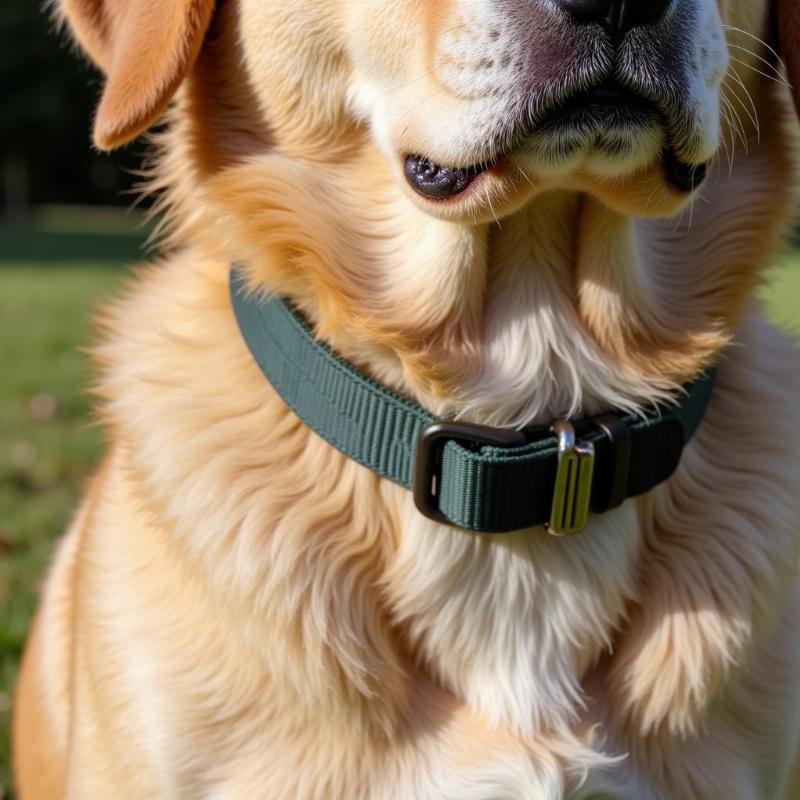Prong collars, also known as pinch collars, are training tools that consist of a series of interlocking metal links with blunted prongs. When used correctly, they are designed to provide a quick, aversive sensation to discourage unwanted behaviors in dogs. However, their use is highly controversial among dog owners, trainers, and veterinarians in the United States. Understanding the proper use, potential risks, and alternatives to prong collars is essential for responsible dog ownership.
Understanding How Prong Collars Work
Prong collars apply pressure evenly around the dog’s neck when the leash is tightened. This pressure mimics the correction a mother dog might give her pups, which is why some trainers advocate for their use. However, it’s crucial to understand that this pressure can be painful and even harmful if the collar is misused. The key to using a prong collar, if used at all, is to administer short, sharp corrections followed by immediate release and positive reinforcement for desired behaviors. Constant pressure or jerking the leash can cause significant discomfort and potential injury.
The Potential Risks of Prong Collars
While some trainers believe prong collars can be effective when used correctly, there are significant risks associated with their use. Physical injuries, such as bruising, punctures, or damage to the trachea and esophagus, can occur, especially with improper fitting or handling. Psychological harm is also a concern. Prong collars can create fear, anxiety, and aggression in dogs, especially if used harshly or inconsistently. These negative associations can hinder the dog’s overall well-being and make training more challenging in the long run.
 Potential Risks of Using a Prong Collar
Potential Risks of Using a Prong Collar
Alternatives to Prong Collars for Effective Training
Many effective and humane alternatives to prong collars exist. Positive reinforcement methods, using treats, praise, and toys, are highly effective and build a strong bond between dog and owner. [how to feed a dog with no teeth](https://beautdogs.us/how-to feed-a-dog-with-no-teeth/) Harnesses, particularly front-clip harnesses, provide better control and discourage pulling without causing pain. Head halters offer gentle guidance and can be especially helpful for dogs who tend to lunge or pull excessively. Consulting with a certified professional dog trainer can provide personalized guidance and help you choose the most suitable training methods for your dog’s specific needs and temperament.
Are Prong Collars Right for Your Dog?
Deciding whether to use a prong collar is a complex decision. While they can be effective in certain situations under the guidance of a skilled trainer, the potential for harm is significant. If you are considering using a prong collar, consult with a veterinarian or a certified professional dog trainer who utilizes positive reinforcement methods. They can assess your dog’s individual needs, help you understand the risks involved, and guide you towards the most humane and effective training approach. old dog rapid weight loss
Conclusion: Choosing the Best Path for Your Dog’s Training
Prong collars for dog training remain a controversial topic. While some trainers advocate for their use in specific situations, the potential for physical and psychological harm is undeniable. Prioritizing positive reinforcement methods and exploring humane alternatives like harnesses and head halters is crucial for responsible dog ownership. Consulting with a qualified professional is essential to determine the best training approach for your dog’s individual needs and ensure their well-being. Remember, building a positive and trusting relationship with your dog through humane training practices is the foundation for a happy and well-behaved companion.
FAQ: Common Questions About Prong Collars
- Are prong collars humane? The humaneness of prong collars is debated. While proponents argue they can be used humanely under expert guidance, the potential for pain and psychological harm raises significant concerns.
- Can prong collars cause damage to a dog’s neck? Yes, improper use or fitting can cause bruising, punctures, and even damage to the trachea or esophagus.
- Are there effective alternatives to prong collars? Yes, positive reinforcement training, harnesses, and head halters are humane and effective alternatives.
- Should I use a prong collar on a puppy? Prong collars are generally not recommended for puppies due to their delicate necks and developing temperament.
- Do prong collars stop pulling? They can suppress pulling, but they don’t address the underlying cause. Positive reinforcement training is more effective for long-term solutions.
- How do I fit a prong collar correctly? A properly fitted prong collar should sit high on the dog’s neck, just below the ears, and be snug but not tight. Consult a professional for proper fitting.
- Are prong collars legal in the US? Prong collars are legal in most areas of the US, but their use is restricted in some places. Check your local regulations.
Related Articles
Beautdogs.us is your premier online destination for comprehensive dog care information, breed insights, and expert advice. We provide a trustworthy resource for both new and experienced dog owners seeking to navigate the world of dog companionship. From breed-specific guidance to training tips, we empower you to provide the best care for your beloved canine companion. Connect with us for personalized support at [email protected] or call us at +1 501-555-7529. Beautdogs.us is dedicated to helping you foster a thriving and joyful relationship with your furry friend.